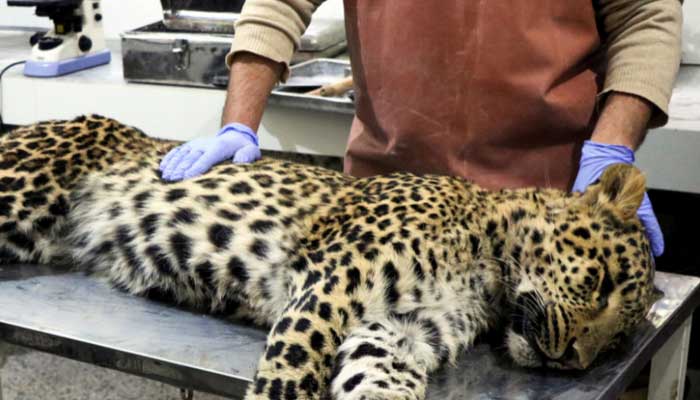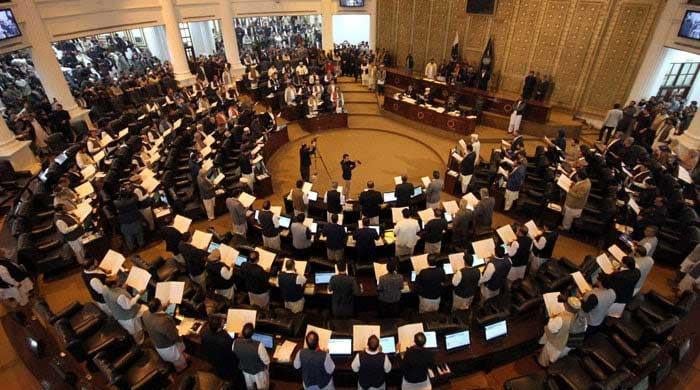Increasing leopard-car collision cases indicate thriving population
"Increase in number of big cats not risky," says wildlife official
March 01, 2023

ISLAMABAD: Several incidents of leopards being hit by motorcyclists are rampantly increasing in Pakistan's northern areas, particularly Khyber Pakhtunkhwa (KP), which is known for its rich tourism.
The increasing number of leopard-vehicle collisions, in which the wild cats are either killed or critically injured, along the highways in KP's different districts indicated a thriving population of the endangered common Asian Leopard.
Therefore, there is a need for a national level of community awareness to respect the habitats and ecosystems of wildlife while venturing into the scenic hilly areas of the country.
Talking to APP, Khyber Pakhtunkhwa wildlife department senior official confided that an Asian leopard was found injured on Kaghan Highway hit by a fast-moving car leaving it traumatised and unable to walk on its hind limbs.
He said the increase in the number of leopards was not a risk rather it indicated a healthy ecosystem, as the wildcat controls the population of wild boars. He added that wild boars are detrimental, if in abundance, to crops, humans, and ecology.
The leopard was a female cat that was timely recovered from Kaghan Highway and shifted to Dhodial Pheasantry, Mansehra for treatment, he added.
The release of the leopardess back into the wild was the decision of the divisional forest officer (DFO) Dhodial, who had ensured the rehab of the wildcat because if it had not been fully recuperated, it would become unable to hunt.
Consequently, it would attack the weakest prey on her food chain which was humans. he shared his insight.
The wildlife official informed that an injured hyena was recovered earlier from Koh-e-Suleiman area and it was rehabilitated and recovered under captivity and then released into the wild.
He added that the KP’s Wildlife Department had a policy to keep wildlife in its natural habitats. Recently, the KP wildlife act was extended to the newly merged tribal districts of Khyber Pakhtunkhwa that were also potential habitats of leopards, hyenas, and wolves among other wildlife species.
There has been frequent leopard-human conflicts in the Khyber districts which has a thriving leopard population and its hunting has been common in that region.
“The wildlife department recorded numerous incidents where people hunt down leopards as it attacked and ate their livestock animals,” he added.
To a question, he informed the department had initiated a compensation mechanism by taking the deputy commissioner’s office on board to provide money in lieu off the animals killed by the leopard. However, it was incumbent on the wildlife department to verify that the livestock animal was predated by a leopard and also by the affected party.
He further informed that hyenas and wolves were found in large number in South Waziristan, while leopards were common in Orakzai, South Waziristan, Karak, Kohat and Hazara region.
The official underlined that community awareness and education had become imperative to ensure wildlife protection and promotion, as these areas were tourism magnets and people want to visit these destinations. Whereas, there is need to develop some standard operating procedures to ensure safety at all ends.
“The wildlife department is already carrying out awareness lectures at schools and colleges for students on wildlife protection and conservation. Most of the students among those have received higher education and are serving at key positions. They have contributed in creating sensitivity among the masses to some extent,” he added.
The official added that the department was also engaging religious scholars and influencers especially in Friday's congregational prayer to participate in the campaign to educate masses on wildlife protection.
The DFO Dhodial informed APP that the wildlife department staff was not well-equipped and trained enough to capture the leopardess, but it handled it through local techniques and shifted it to the pheasantry for medical care.
The local vet and doctor had examined the female wildcat. There were no fractures on the body, but she was hit by a vehicle that left her paralysed for some time. However, the animal was fine and healthy, and would be released in the wild.
He informed that the wildlife department had village level committees to apprise the locals on such incidents and precautionary measures to avoid conflict.











